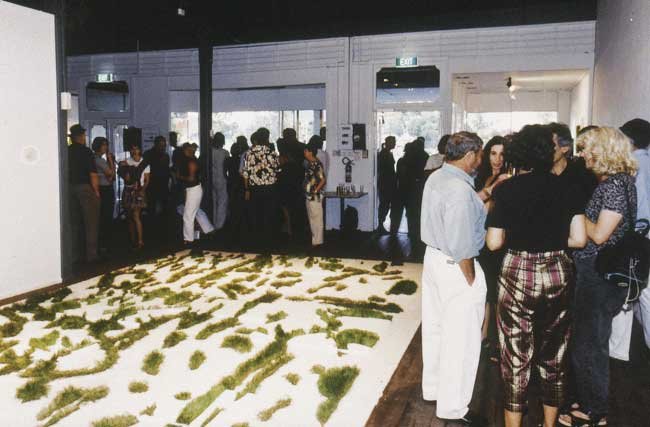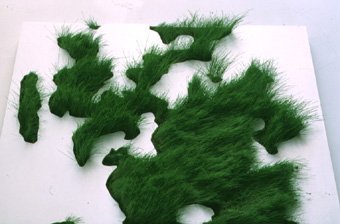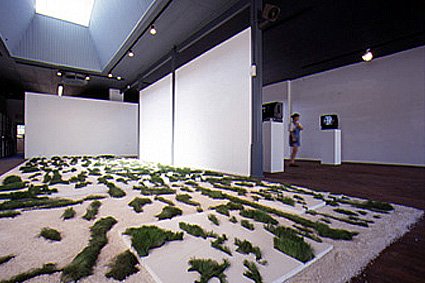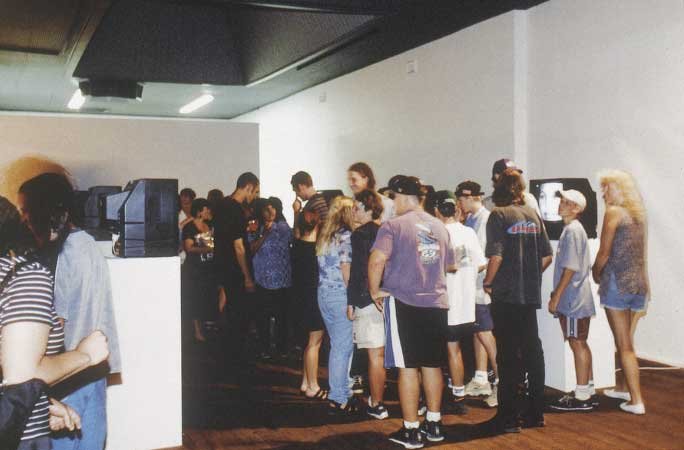Salvatore Falci, Silent Communication and Grass, Salt (1998)
Artist: Salvatore Falci
Work: Silent Communication and Grass, Salt (1998)
Location: Kellerberrin, Western Australia
At first sight, the two installations developed by Salvatore Falci during his residency at IASKA could appear strikingly different. The first work, titled 'Silent Communication' consists of three pairs of videos in black and white depicting people's faces which are shown on monitors placed on opposite sides of the gallery. Subtle and rapid changes of expression animate the faces that appear engaged in a silent psychological exchange across the empty gallery space.
The installation's lay-out reproduces the situation set-up by the artist for the filming sessions. This involved inviting people to sit across a small table and to look at each other in silence for three minutes. Two cameras recorded simultaneously the changes in facial expressions of the sitters, who are all residents of Kellerberrin and other nearby towns. The sitters - who vary in age, gender, race and class - are sometimes strangers to each other but, more often, they are linked by pre-existing social bonds - they are husband and wife, parent and child, teacher and student etc.
In the other half of the gallery, the artist has installed a large grass and salt piece. This work was produced by spreading a mixture of grass seeds and sand on the footpath in front of the gallery and leaving it on the ground for twenty four hours to be trampled and spread around by the pedestrian movement. The random effects of the everyday pedestrian traffic on the ground covering are evidenced by the growth patterns of the grass which were carefully watered and cared for by the artist inside the gallery space.
An important component of this work is constituted by the direct involvement of the community. Salvatore Falci has, in fact, offered for sale each of the individual 166 squares which form the grided floor installation. The sale price of each piece was sufficient to cover the production costs of a box to preserve a section of the grass jigsaw-puzzle. Salvatore Falci's intention was to bring people closer to contemporary art by persuading them to install the boxed grass pieces in their own homes. Over thirty pieces have been sold in this way. After the exhibition the artist intends to ask the collectors to send him photographs of the pieces in their homes. The choices made by the buyers, their future use of the pieces are therefore considered as part of the work.
Despite their apparent differences these two installations stem from a common approach which centres on the broad notion of 'relationship'. Salvatore Falci's work is always the result of a process of interaction between a community, a site and the artist. The objects exhibited in the gallery are only the visible part of an artistic whole which also include the diverse processes that led to their conceptualisation, production and distribution within the fabric of society. For Salvatore Falci, therefore, art making is much more than the production of aesthetic fetishes as it involves the creation of small, but poetically subversive, transformation of the practices, codes and habits which form the subliminal texture of everyday life.
“...the work has a poignant reading for the farmers of the region, who have seen salt claim up to 10% of the arable land in the district...Silent Communication is a haunting work that builds into an emotional climax ... It is this ability to reveal the simple humanity of everyday life that has made his residency so successful, and its impact so enduring, for his new friends in Kellerberrin.” Ted Snell, The Australian, January 1, 1999
About the artist:
Salvatore Falci (Italy) is one of the most distinctive artists to have emerged from Italy in the last decade. His work has been shown in major international exhibitions such as the Venice Biennale and Edge '92 and in many other venues in France, the U.S.A., Spain, Italy and the UK. Salvatore Falci currently works as a Senior Lecturer and course coordinator with the Accademia Carrara in Bergamo. For Salvatore Falci, art involves the creation of small, but poetically subversive, transformation of the practices, codes and habits which form the subliminal texture of everyday life.




